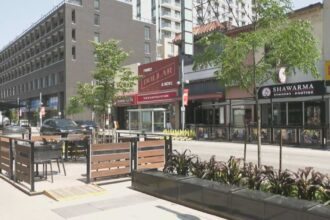As temperatures soar across Northern Ontario this week, residents are demonstrating remarkable ingenuity to beat the relentless heat that has settled over the region. With thermometers climbing well above 30 degrees Celsius and humidex values pushing into the low 40s, communities from Thunder Bay to Timmins are adapting with both traditional and innovative cooling strategies.
“I’ve never seen it this hot for this long,” remarks Eleanor Sanderson, 78, a lifelong Sudbury resident who has transformed her basement into what she calls a “cooling sanctuary” for herself and three elderly neighbors. “We take turns bringing cold drinks and reading books. It’s become something of a social event despite the uncomfortable weather.”
Health authorities across the region have issued heat warnings, with particular concern for vulnerable populations. Dr. Maya Krishnan, Chief Medical Officer for the Northern Ontario Health Unit, emphasizes the severity of the situation: “This isn’t just uncomfortable—it’s potentially dangerous. We’re especially concerned about elderly individuals, those with chronic health conditions, and people working outdoors.”
The extended forecast offers little relief, with meteorologists predicting the heatwave could persist for at least another week. This prolonged exposure has prompted municipalities to extend cooling center hours, with some communities like Thunder Bay and North Bay keeping designated facilities open 24 hours to accommodate residents without adequate home cooling.
In smaller communities where formal cooling centers are limited, residents have devised creative alternatives. In Cochrane, the local hockey arena has been repurposed as a community cooling space, while in Kapuskasing, the public library has extended its hours and added extra seating in its air-conditioned reading rooms.
The heatwave has also sparked a surge in community support initiatives. In Sault Ste. Marie, the “Cool Neighbor” program matches seniors and other vulnerable residents with volunteers who check in daily and assist with tasks that might expose them to extreme heat. “We’ve had over 200 volunteers sign up in just three days,” notes program coordinator Janine Whitfield. “The northern spirit of looking after each other is very much alive.”
For those who must work outdoors, employers are implementing adjusted schedules. Road construction crews in Thunder Bay have shifted to night shifts, while forestry operations across the region have modified work hours to avoid midday heat.
Indigenous communities are particularly affected, with some remote locations facing power grid strain from increased cooling demands. In Attawapiskat First Nation, community leaders have established a rotation system for air conditioning use to prevent brownouts, while also reviving traditional cooling practices like setting up shaded gathering areas near water bodies.
The economic impact is becoming evident as well. Tourism operators report mixed effects—beach destinations are seeing increased visitors, while hiking and outdoor adventure companies have had to modify or cancel excursions. Meanwhile, retailers across Northern Ontario report shortages of fans, portable air conditioners, and cooling accessories.
Climate scientists point to this event as consistent with projected warming trends for the region. “While we can’t attribute any single weather event directly to climate change, the increased frequency and intensity of heatwaves in Northern Ontario aligns with climate models,” explains Dr. Alisha Mohammed, climatologist at Laurentian University. “What was once considered exceptional may become more commonplace in coming decades.”
As Northern Ontario navigates this challenging period, the resilience and community spirit characteristic of the region are prominently on display. From municipal responses to neighborhood initiatives, residents are demonstrating that adaptation comes in many forms—some high-tech, others refreshingly simple.
As the mercury continues to climb, the question remains: is this extended heatwave an anomaly, or is it providing a glimpse into Northern Ontario’s future climate reality?


















